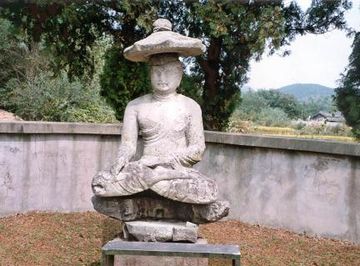경주 안계리 석조석가여래좌상
| 경주 안계리 석조 석가여래좌상 Stone Seated Sakyamuni Buddha in Angye-ri, Gyeongju |
|
 경주 안계리 석조석가여래좌상, 국가문화유산포털, 문화재청. |
|
| 대표명칭 | 경주 안계리 석조 석가여래좌상 |
|---|---|
| 영문명칭 | Stone Seated Sakyamuni Buddha in Angye-ri, Gyeongju |
| 한자 | 慶州 安溪里 石造 釋迦如來坐像 |
| 주소 | 경상북도 경주시 강동면 안계리 산8-4번지 |
| 지정(등록) 종목 | 경상북도 문화재자료 제92호 |
| 지정(등록)일 | 1985년 8월 5일 |
| 분류 | 유물/불교조각/석조/불상 |
| 수량/면적 | 1구 |
| 웹사이트 | 경주 안계리 석조석가여래좌상, 국가문화유산포털, 문화재청. |
|
|
|
해설문
국문
이 석불좌상은 허리가 가늘고 가슴과 어깨가 발달한 것으로 보아 신라 8세기 전성기의 불상으로 판단된다. 양 팔을 신체와 뚜렷하게 구분되도록 조각하였음을 큰 특징으로 들 수 있다.
1999년 이 곳에서 ‘安溪寺(안계사)’라고 새겨진 기와가 발견되었다. 보수하기 전에는 여래좌상의 머리에 석등의 지붕돌이 얹혀 있었고, 탑 부재를 대좌(臺座)로 이용하고 있었다. 2002년과 2003년의 발굴 조사 후 대좌를 보강하여 현재의 상태로 복원하였다.
불상 주변의 석재 중에는 앞면에 무릎 꿇고 마주앉은 2명의 사람, 뒷면에는 3층 석탑과 보살상(菩薩像), 양 옆면에는 사자가 새겨진 석재가 있어 주목 된다.
영문
Stone Seated Sakyamuni Buddha in Angye-ri, Gyeongju
This stone statue depicts Sakyamuni, the historical Buddha who lived in ancient India, and is presumed to date to the 8th century at the height of the Unified Silla period (668-935).
The Buddha is depicted with a slim waist, a broad chest and shoulders, and wide knees. Its arms are set apart from the body. The right hand of the Buddha reaches down toward the ground, and his left hand rests on his lap, indicating his defeat of worldly desires and his attainment of spiritual enlightenment.
In 1999, a roof tile with the inscription of “Angyesa Temple” was found in the vicinity. In 2002 and 2003, two excavations of the area were conducted, after which the buddha was repaired and placed atop a lotus-shaped pedestal.